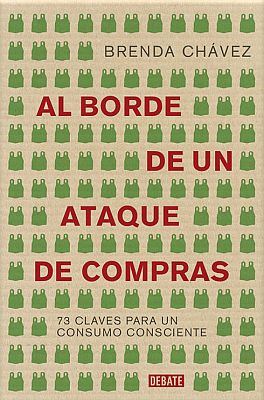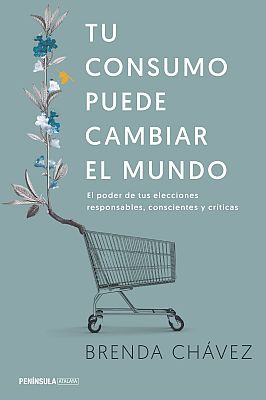Young people’s consumption and the climate crisis
- Dossier
- Feb 20
- 8 mins
Something is changing in young people’s consumption habits. The current economic situation of precariousness and the evidence of the climate crisis have heightened socio-environmental awareness. Young people are beginning to take the lead in the transformation of consumer society.
There is a growing readiness among young people towards collaborative or more sustainable forms of consumption that reflect another way of going about consumption, out of necessity or changes in their spending habits and ways of relating to one another. Also as a reaction to the precariousness they suffer, in the face of a wasteful production model, or due to greater environmental awareness. But, before addressing these forms of consumption, let’s examine the context in which they came about.
In 2018, the United Nations Environment Programme Emissions Gap Report[1] warned that twelve years (until 2030) remained to solve climate change or the future generations will inherit even worse climate change. A message that Greta Thunberg has endorsed, promoting the Fridays for Future youth movement, which Extinction Rebellion, Madres por el Clima [Mothers for Climate], Teachers for Future and, more recently, Trabajador@s por el Clima [Workers for Climate] have joined.
A rising awareness since the crisis
Back in 2007, the Nielsen consulting group already pointed out that global concern over climate change was on the rise: two out of every five people (42 %) believed that governments should take action (in Spain it grew four points), an upturn not seen since the late 1980s, which made it the fourth global concern after the economy, health and unemployment.[2]
In 2012, Nielsen also revealed that, overall, 63 % of those under the age of 40 preferred goods with social and environmental benefits (60 % in Spain), and 46 % would pay more for them (31 % here). The causes that most mobilised them were sustainability (66 %), the development of training in science, technology, engineering and mathematics (56 %) and the eradication of poverty (53 %). Interestingly, the most receptive areas were not the United States (with 35 %) or Europe (with 32 %), but Asia and the Pacific (with 55 %), the Middle East and Africa (with 53 %) and Latin America (with 49 %).[3]
More conscious consumers
According to the UN, the consumption of organic goods and services will grow by 50 % in the coming decades. In Spain, 2020 will see a 12 % increase: from a turnover of 905 million euro in 2008, this year we will reach 12,182 million. Already in 2014, the Intelligence Unit of The Economist (neoliberal bible), identified responsible consumption as the most prominent trend; consumption that is guided by social and environmental criteria over and above quality-price. That same year, the TrendWatching agency highlighted a rising consumer thirst for guilt-free consumption, which prevents human exploitation, animal cruelty and harmful products. Both sources noted the existence of consumers mindful of the traceability and impact of their choices.
One year earlier, in 2013, the consumer study From Obligation to Desire, conducted by three North American consulting firms, pointed out that global consumers uniting style, social status and social responsibility amounted to 2.5 billion, one third of the world population. And they redefined consumption, because for them “the right thing to do” is “the cool thing to do”. [4]
These consumers are classified as “aspirationals”[5]: 52 % are women, 40 % millennials (19-36 years), 37 % Generation X (born between 1960 and 1980), 34 % baby boomers (1946-64) and 29 % seniors. The average age is 39; 49.4 % are the primary shopper in the household; 46.8 % are parents with children under 17 and 59.1 % live in urban areas. They are described as the potential “turning point” of global consumption, marketing calls them “active” or “global participants”, because through their actions and habits they are able to alter the development, production and sale of goods or services, given the pressure they subject companies to. For example, the increased awareness of animal cruelty has made luxury brands such as Gucci, Armani and Michael Kors give up using fur.
Young people seek out brands that reflect their values, share their knowledge, technology and benefits to help bridge overall gaps.
These new consumers, among whom there are many young people, are concerned about their health and well-being; they aspire to have a meaningful life; they assert their freedom and the right to have a voice and control; they challenge the interests behind the messages they receive; they are fond of altruistic projects and practical innovations; and they engage in conversations (physical or virtual) with brands, which they no longer consider “gurus”, but “facilitators”.
They also appreciate concepts such as cooperation, community, sustainability, authenticity and transparency. They see problems as opportunities for solutions. Therefore, they seek out brands (or forms of consumption) that reflect their values, share their knowledge, technology and benefits to help bridge overall gaps. [1]
Precariousness and technology also on the rise
Millennials landed in the labour market in the midst of the crisis and, like Generation Z (born between 1995 and 2002), they suffer its negative consequences when it comes to wages and professional expectations. A context, along with the technological state of affairs, which makes them more price-sensitive, brings them to seek more value for their purchases and makes them more practical. Mobile phones, computers and tablets become their operation centre: music, camera, television, cinema, leisure, their calendar, their relationships. They shop more online and adopt other forms of consumption, to get around and to live, which we can sum up in the following trends:
[1] Consumer Trend Forecasting 2011. WGSN.
Millennials and centennials (up to 20 years old) are concerned about the environmental impact of their food, its composition, the procurement channel and its image.
1. Healthier and more sustainable food
The Findasense study Las cosas sobre la mesa [The Things on the Table] shows that millennials and centennials (up to 20 years old) are concerned about the environmental impact of their food, its composition, the procurement channel and its image. What’s more, they use more applications that provide nutritional information for shopping, such as GoodGuide or Buycott (in English) and Yuka (in Spanish), or Ingred, which reports potentially harmful substances in cosmetic, hygiene and food products.
2. Collaborative consumption
This system allows them to enjoy, rent, exchange, reuse or share goods or other services without owning them. According to Time magazine, the sharing economy is one of the ten ideas that will change the world. The publication claimed that one day we will look at the 20th century and we will wonder why we consumed so much.
Peer-to-peer (P2P) online platforms save on costs, resources and put words such as bike sharing, shared parking and co-housing on everyone’s lips or disseminate information about spaces for co-working, leisure, production or consumption (such as shared vegetable gardens or consumption groups) and trading platforms with no intermediaries. The website consumcolaborativo.com features a large directory. Collaborative consumption gained a firm footing with the crisis and saw the rise of businesses such as BlaBlaCar, Carpooling and Airbnb. It is not free of controversy as far as labour and tax-related matters are concerned, such as those revolving around Uber, Cabify, Deliveroo and Airbnb. In parallel, cooperative alternatives have emerged such as Som Mobilitat [a non-profit consumer cooperative fostering the transition towards more sustainable mobility] and Fairbnb [an ethical home-sharing platform], both promoting a social and solidarity-based economy.
3. Zero waste
This movement, booming among young people, minimises waste by applying five principles: refuse (what you do not need, packaged or disposable items); reduce consumption (of goods, energy, light, water, etc.); reuse products, extending their life; recycle (what cannot be refused, reused or reduced); and rot organic waste (food and vegetable scraps), composting them to make fertiliser. Zero waste endeavours to avoid the use of containers and plastics, to promote reusable containers (tupperware, moulds, bottles, cloth bags), to foster the purchase of loose products or zero waste items such as menstrual cups, shampoo bars, body butter bars, refillable detergents and cleaning products, biodegradable brushes, plastic-free scourers, bars of soap, etc.
4. Second hand
Vilified for a long time, today second-hand products have gained popularity through online stores or platforms for the purchase and sale of fashion, appliances and technology, which provide these items at a good price, somewhat mitigating the environmental impact of “disposable” culture, which discards them before time and in good condition. Even in the luxury goods sector, resale services have begun to appear, something that was unthinkable years ago, such as The RealReal, by Stella McCartney, which resells garments from its own brand and other brands.
5. Other ways of living
Access to a first home and to credit is difficult with an unemployment rate of 33.14 % among those 16 to 24 years of age. Therefore, flat sharing or building one’s own home are options that are increasingly explored. There are modular eco-homes (built using eco-friendly and sustainable materials) with less ecological footprint and initiatives such as co-housing, which allows users to co-design their homes collectively.
6. Cooperation is loving
The governance of cooperatives allows members to participate democratically in decision-making. In recent years, renewable energy cooperatives have emerged, such as Som Energia in Catalonia or the cooperative telephone operator Som Connexió. With the same philosophy, several cooperative supermarkets are planned in Barcelona and Madrid that will allow their members to buy sustainable products at better prices in exchange for their collaboration for a few hours per month.
7. Getting back to “doing”
The term prosumers (producer-consumers) describes those who produce goods to sell or consume. It stems from a trend towards the “reappropriation” of doing, which responds to the rising “disappropriation” by industries in recent decades. Examples thereof are the DIY (Do it yourself), homemade, handmade and the right to repair movements (demanding the right to repair goods instead of buying them new), custom clothing, and growing democratisation and production access through process control (supported by the Internet, with creation technologies, 3D printers, etc.).
Trend consultancies point out that the last recession stimulated creativity as a personal expression, as a challenge to convention – with the conviction that solving problems is not just a matter of money, but of devoting time to them – and as part of the emerging collective consciousness (and youth awareness) that believes that we decide the world with every action.
Recommended publications
 Al borde de un ataque de compras Brenda Chávez. Debate, 2019
Al borde de un ataque de compras Brenda Chávez. Debate, 2019 Tu consumo puede cambiar el mundoBrenda Chávez. Península, 2017
Tu consumo puede cambiar el mundoBrenda Chávez. Península, 2017
The newsletter
Subscribe to our newsletter to keep up to date with Barcelona Metròpolis' new developments




